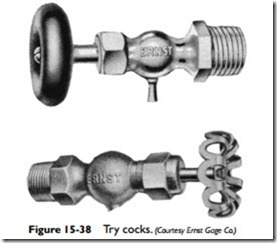Steam Boiler Aquastat
Aquastats have been used on some steam boilers to control temperature limits. It is similar in function to the pressure control on a steam boiler or the fan and limit control on a forced-warm-air furnace. Aquastats are used much more often on hot-water boilers to control temperature limits or to operate the circulator (pump). See Hot-Water Boiler Aquastats in this chapter.
Blowdown Valve
Sediments and contaminants in the water will settle out over a period of time and accumulate at a low point in the bottom of the boiler. These can be removed through a blowoff valve installed in a line connected to the lowest part of the boiler. The blowoff valve is opened periodically, and the accumulated sediments are drained off.
Steam boilers operating at 15 psig or less require a blowdown valve the full size of the boiler connection. Steam boilers operating at pressures greater than 15 psig require at least two such blowdown valves. One or both of the valves must be the slow opening type.
Each water column and float type low-water cutoff must also be equipped with a blowdown valve.
Foam sometimes forms on the surface of the boiler water. This is usually indicated by drops of water appearing with the steam. This condition is caused by the presence of oil, dissolved salts, or similar organic matter in the water. One method of eliminating this prob- lem is by draining off part of the water in the boiler and adding an equal amount of fresh, clean water. Another method involves blow- ing the foam from the water with a specially connected pipe or hose. The boiler should have a blowdown tapping for this purpose.
Try Cocks
Try cocks are small valves installed on steam boilers at the safe high-water level and at the safe low-water level (Figure 15-38). When the boiler water column is inoperable, try cocks function as a backup system to determine the water level. The water level is determined by opening slightly first one try cock and then the other. The water level is indicated by the color of the plume escaping from the try-cock orifice. A steam plume is characteristically colorless and will indicate that the water level is too low (i.e., below the level of the try-cock orifice). Water, on the other hand, is characterized by a white plume. A false water-level reading will be obtained if the try cock is opened too wide when the level of the water is only slightly below the level of the try-cock orifice. The violent agitation of the water caused by a wide-open try cock will result in some of
the water escaping, giving the false impression that the level of the water in boiler is at or above the try-cock fitting.
On large steam boilers a third try cock is often installed between the other two. Sometimes a try cock on these larger boilers is at a level too high to reach. When this is the case, chain-operated, lever- type try cocks are installed.
